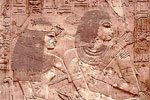|

Although many archaeological expeditions of the nineteenth century
included photography as an aspect of recording, graphic artists
remained at the heart of expeditions dedicated to epigraphy, the
recording of monumental scenes and hieroglyphic inscriptions.
Partly this was due to the limitations of publication, but the
technique of photography itself imposed its own strict bounds.
The camera gives photography what Frith termed its "essential
truthfulness," but it is a selective truthfulness, in epigraphy
often deceptive and ultimately not truthful. A photograph necessarily
shows a portion of a monument under a single set of lighting conditions.
On a carved wall, for example, lines inscribed parallel to the
angle of light will tend to disappear, while elsewhere, small
scratches can cast dark and deceptive shadows. For this reason,
interpretive drawings that emphasize the original decoration of
the wall — and that artificially minimize extraneous damage
— are the definitive documents, which photography can only
complement.
In the modern study of Egyptian monuments, older photographs are an invaluable tool. Often, with their help, the bubbles on the surface of a salt-encrusted block may emerge as the deformed but yet recognizable forms of a human head or a snatch of inscription. Even general views and landscape shots contain decisive information. The pits, trenches, and debris dumps of archaeological excavations have altered the original terrain of Thebes and other sites. Wadis are filled in, and mounds stand where once none existed. Though even in the mid-nineteenth century the monuments and landscapes of Egypt were veiled beneath ruined architecture and medieval detritus, early pre-excavation photographs give us the best idea of the possible ancient topography of a site. This can assist in the interpretation of Egyptian texts, and in understanding the influence of the immediate landscape on the design and appearance of individual Egyptian monuments.
The glass plate collection from which these portfolio images were produced was purchased in Luxor in 1987 from a local vendor, with the purpose of augmenting the photographic archives of the Epigraphic Survey and its documentary record of Egyptian monuments, particularly those in the Theban area. The prints of the Lost Egypt portfolio series were produced at Chicago House, the field headquarters of the Survey in Luxor.
«
previous
3 of 4
next
»
|
 |

|
 |


Figure
1, Vol III: Tomb of Ramose. »
| E
X P L O R E |
| The
Further Exploration page has many links to great
sites about Ancient
Egypt. |
|
|
|